|
FAQs on Anemone Identification
42
Related Articles: Anemones,
Bubble
Tip Anemones, LTAs, Cnidarians, Coldwater Anemones, Colored/Dyed Anemones,
Related FAQs: Anemone ID 1, Anemone ID 2, Anemone ID 3, Anemone ID
4, Anemone
ID 5, Anemone ID
6,
Anemone ID 7,
Anemone ID 8,
Anemone ID 9, Anemone ID 10,
Anemone ID
11,
Anemone ID 12, Anemone ID 13, Anemone ID 14, Anemone ID 15,
Anemone ID
16, Anemone ID 17, Anemone ID 18, Anemone ID 19,
Anemone ID 20,
Anemone ID 21, Anemone ID 22, Anemone ID 23, Anemone ID 24, Anemone ID 25, Anemone ID 26, Anemone ID 27, Anemone ID 28, Anemone ID 29, Anemone
ID 30, Anemone ID 31,
Anemone ID 32,
Anemone ID 33,
Anemone ID 34, Anemone ID 35,
Anemone ID 36, Anemone ID 37, Anemone ID 38, Anemone ID 39, Anemone ID 40,
Anemone ID 41, Anemone ID 43,
Anemone ID 44,
Anemone ID 45,
&
Cnidarian
Identification,
|
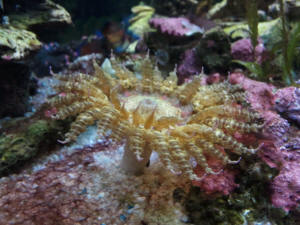
|
 |
New Print and
eBook on Amazon:
Anemone Success
Doing what it takes to keep Anemones healthy long-term
by Robert (Bob) Fenner
|
|
Unidentified Anemone 11/9/12
I'm very interested in knowing what species of anemone this is. It came in a
shipment from Jakarta that I received about a week ago. It's an aggressive
eater (I'm feeding it Mysis shrimp) but it closes up under strong lighting.
The closest thing to it that I've seen is a waratah anemone (*Actinia
tenebrosa*) but I'm pretty sure that this is a different species. Any
feedback would be much appreciated.
--
*Thank you, Aaron Dragseth*
<Mmm, the tentacle ends/tips aren't "right" for Actinia tenebrosa... My
guess is that this is an aberrant Entacmaea. A beauty.
Bob Fenner>
|
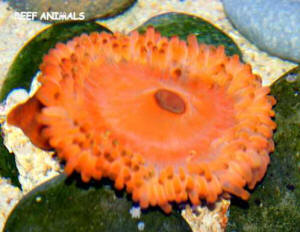 |
Re: Unidentified Anemone
11/9/12
Thank you for your feedback. I agree that it isn't an Actinia tenebrosa but
it also doesn't really look like or have the same behavior as Entacmaea
quadricolor. Are there other species of Entacmaea?
<Not as far as I'm aware... but have seen E. quadricolors look like this
from rough handling, shipping>
I actually received 3 of these anemones. They were all firmly attached to
small pieces of substrate that they have continued to cling to even a week
later. Two of the anemones
had the same foot but a completely separate set of tentacles and each had
their own oral disk. They remind me of the aggregating anemones
(*Anthopleura elegantissima*)
<Yowzah! I did a histological study of this... clone anemone... common off
of San Diego's coast... for a marine invert. class... many years ago>
that are common in my local California tide pools. .
<D'oh! That and the giant green of the same genus. Bob Fenner>
Re: Unidentified Anemone 11/9/12
I know what you mean when you say "but have seen E. quadricolors look like
this from rough handling,", I agree. The big difference on these anemones
are that they seem to be very healthy. The tentacles are very sticky, in
fact I would say that they are stickier than those on even the healthiest of
bubble-tip anemones.
Also, the foot is more like that of the our local Anthopleura species, very
leathery with an extremely strong adhesion to the substrate. An unhealthy
Entacmaea would never have such a strong hold on the substrate and the foot
is much softer. With that said, I currently have it listed for sale as a
Crimson Mystery Anemone (Actinia sp.?)
<A good name>
What do
you think?
<I do wish I were home, w/ my reference works... Am out visiting in Europe.
Maybe a (hard) run through Daphne Fautin's "Hexacorallians of the World"
(.com),
http://hercules.kgs.ku.edu/hexacoral/anemone2/index.cfm
will be productive>
LOL! It's interesting that you worked on those California Tidepool
anemones, I remember my marine biology teacher daring us to stick our
tongues in them and most of us did!
>"Squirt!"<
Would that even be legal today?!!
<Heeeee! BobF>
Help with anemone identification 11/9/12
Hello Bob, I thought that you would find this reply from Karen Sanamyan
interesting. I'm not sure if you are familiar with her or not but she is a
marine biologist at the Kamchatka branch of the Pacific Institute of
Geography, she specializes in the taxonomy of Actinaria and is one of the
authors of Actiniaria.com. It sounds like we have an
<I'll say! Thanks for sending this along Aaron. Wondered re the apparent
empty-of-tentacles space on the face, the open mouth... BobF>
Subject: Re: Help with anemone identification
11/10/12
Hello,
Well, very interesting species.
It has capitate tentacles (small spheres on the tips of the tentacles), such
tentacles usually occur in stone corals and corallimorphs, and in general
are not characteristic for true anemones (Actinaria), (except Telmatactis
and a few other Actinarian genera).
Further, on your photo I see that it has several some tentacles arranged
radially of the disk (arrows on attached photo). This feature excludes all
stone corals. Several true anemones have tentacles arranged in radial rows
(e.g. Stichodactyla), but they all are very different and have no capitate
tentacles. So, this is a Corallimorph species (corallimorphs are all
"mushrooms", e.g. Discosoma, Rhodactis, Corynactis, Ricordea and others -
you know). However, the species on your photo cannot be identified with any
known Corallimorph species, I think this is undescribed (=new) species.
Best wishes
Karen Sanamyan
http://actiniaria.com |
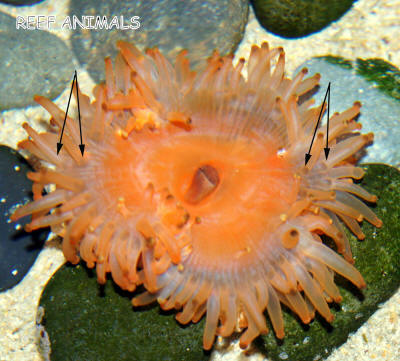 |
|
question about Anemone, mainly ID
9/24/12
Hi guys
<Cam>
Awesome website which I'm always learning from. Thank you!
<Welcome!>
I have had this anemone for 1.5 years now and it just won't stop
growing!
It has never split in my tank. It was given to me by a friend whose
anemone kept splitting and mine is one if his clones. His one
hasn't done too well in his tank but he does have other anemones in his
tank (I know, I know - I've told him). I did write to you guys
about 6 months ago to try and get an idea as to what type of anemone
this is (among other things). You thought it might be Heteractis
Malu.
<Might be... or perhaps Heteractis magnifica... now that the pedicle
looks so much lighter>
But Now I'm not so sure. It is currently 12" x 16"
<Oh! Not likely H. malu then... too large>
and that is just the top 2/3rds. The tentacles are about 4" long.
During the day it's mouth is open a little. 1" at the most. It's
been doing this for months. I was a little worried at first but it
still is growing and hasn't lost any colour. I've tried feeding it
cut up, uncooked shrimp which it used to devour but since the clowns
have started hosting in it (6 months ago) it doesn't eat from me.
When I feed Mysis shrimp (about 2-3 times a week) I do give a big squirt
to the clown fish so it's maybe getting some food that way. From
what I've read the H. Malu has rather short tentacles which this one
never does. Is it possible I've got a Crispa?
<Possibly; but my guess is on the Ritter's/Magnificent>
I have a RSM 250l tank with a Vortech mp10 e (in wave maker mode) and
using a Deltec skimmer. I've had this set up for 20 months. Temp
sits around 27-28. Touches close to 29 on a hot day. NH4 0;
NO2 0; NO3 3; Mg 1350; Ca 410; Alk 9.5 dKH; phosphate 0.68; SG 1.025;
Tunze ATO. Using standard T5 tubes. I have a much
larger tank (a bit over 1000l) on order - woo hoo!
<Nice!>
Thanks again
Cam.
It's mouth is about where the Royal Gramma is :)
<A keeper. Bob Fenner>
|
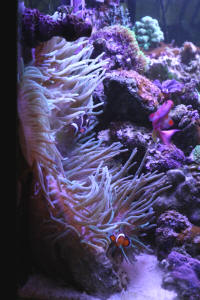
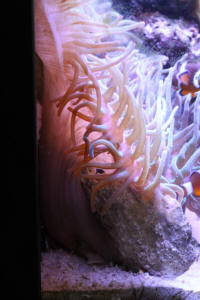 |
|
Help with identity of Anemone
6/15/12
Hi all,
<Hey Paul>
Please see attached an image of a Mystery Anemone I have in my tank. I
bought some Zoas approx 6 months back and when I got them home found a
little hitchhiking anemone on the live rock. It has since grown from
approx 1cm across to 8cm across, and split twice leaving me with three.
I personally like the look of them, but have no idea what they are, how
large they might get, or how common it is for them to split - does 1
become 2, become 4 etc...?
<Quite>
I had assumed some kind of LTA, but recently saw an article stating that
LTA's do not split/clone themselves - I clearly watched this anemone
split yesterday, so I know it hasn't been fragged by a falling rock etc!
Any thoughts?
<Ah yes. This is highly likely an Anemonia sp. Please see here re:
http://www.wetwebmedia.com/AnemoniaF4.htm
Thanks as always,
Paul.
<Welcome in kind. Bob Fenner>
|
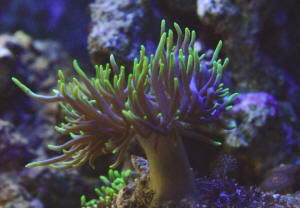 |
|
Anemone? Nope, Corallimorph: Pseudocorynactis spp. –
6/6/12
Hello,
<Hello there, Lynn here this evening.>
Was wondering if you know what these are.
<Yep, although it appears very anemone-like, it’s actually a
Corallimorph (e.g. Ricordeas, mushroom corals, etc.) in the genus
Pseudocorynactis, possibly P. caribbeorum, aka the “Orange Ball
Corallimorph”. We have quite a few references to these in our
FAQ’s but you can start with the one titled “Good or Bad Hitchhiker?
Usually Okay: Pseudocorynactis spp. -- 8/3/10” at the following link and
refer to the links listed within:
http://www.wetwebmedia.com/MushrIDF6.htm?h= >
They come out / open up at night. I only see them for a few minutes
after the light comes on in the morning.
<That’s fairly typical. Interestingly enough, in the wild they’re
nocturnal, but in home aquaria they can sometimes switch to a diurnal
pattern.>
Looks like it has a solid but transparent cone-like base with tentacles
that come off a ring. (Yes, I have a hair algae problem.)
<You have my sympathies. The good news is that you’re at the right
place! We have a lot of information regarding this topic, so if you need
any help, do use our Google search engine for a list of links:
http://www.wetwebmedia.com/Googlesearch.htm >
Thanks for all You do.
<You’re very welcome. Take care, Lynn Z>
|
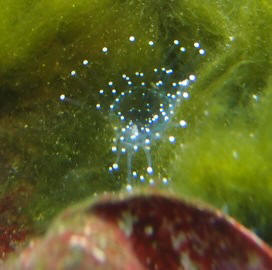 |
|
anemone ID and care
4/26/12
Hi again crew hope you are all well.
<Hello Simon>
Can you please ID this anemone for me and give a little information on
care. i.e. flow rates, feeding, lighting etc. Also would it be a good
host anemone for my pair of Clarkii clowns?
<You have a Macrodactyla doreensis aka Long Tentacle Anemone and it is a
natural host for Clarkii Clowns. Read more here--
http://www.wetwebmedia.com/macrodoreensis.htm
http://www.wetwebmedia.com/ltasysfaqs.htm >
Thank you in advance
<Quite welcome>
Simon
<Jordan>
|
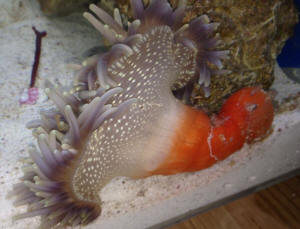 |
|
Lighting and IDs 1/27/12
Hi Crew,
<Hello Rick>
I am after your opinion about my Lighting - currently I have 3 x
120W banks of LEDs as in the picture attached (LED Current).
The tank seems happy enough although it has only been set up for
a few months. All the stock in it are out of several nanos
I've had scattered around the house for about 5 years.
I've very good coralline growth in the new tank and bulk live
Pods and Mysis shrimp due to the 300Lt fishless sump.
<Nice.>
The tank contains a full reef with Live Rock, Fish, SPS and LPS
corals.
The water level from where the lights are mounted to the top of
the aragonite bed is approx 600mm.
I am a bit concerned I've mucked up the ratios of the LED
banks and was after your opinion on light spectrum.
The new banks I'm thinking of building will look like the
picture "LED New"
Can I ask your opinion on the light spectrum and ratios I'm
considering?
<Sure. The 20K LEDs are not much use for growing corals,
at least the corals we commonly keep in our aquaria. I
would not waste the energy on these LEDs but direct it toward the
usable spectrum need by corals (420-700nm). I would not use
any LEDs below 400nm as you are then getting into the UV range
which could/can cause molecular damage to some animals in
your system.>
In addition to the lighting configuration I'm considering , I
am also planning on building 2 x Black Light bars at 18
Watt each to help fluoresce the tank.
<Would not use this as well as they are well into the UV range
and will be hard on the eyes with extended viewing of your
aquarium. Depending on the intensity, the black light may
even damage your eyes if looking directly at them.
At what Wave length will I be exposing the live stock / bacteria
to dangerous levels of U/V radiation?
<Anything below 400nm. UV is in the range of
10-400nm. Below 10nm is the X-Ray spectrum.
Do you think 360nm would be ok, would the 400nm be just as
effective, or could I go lower?
<I personally would not use anything below 420nm.>
Two more questions regarding an ID. See picture
"ID".
This animal has gotten into my sump obviously through live rock,
it doesn't do any damage (except eating the occasional baby
Bristle Worm}. The animal lays flat on the aragonite and very
quickly closes up as food touches or floats over it. It is an
Omnivore as I've seen it eat anything from bits of algae to
shrimp. It's had a few goes at larger Bristle worms but
lets them go after closing around a portion of them, however, it
has no problem chomping up the babies.
<Appears to be a Rock/Flower Anemone, an Actinia of
some type. Bob may input here with a more accurate
ID.>
The next one is a coral that I haven't found conclusively
what it is, It may be some type of brain but the closest pictures
I can find suggest a moon coral. I'm unsure where to place
it, whether on the aragonite bed or on the live rock. The coral
fluoresces beautifully at night under the moon lights and
exceptionally with a jigged up 360nm LED.
<Appears to be a Faviid species, possibly a Moon
Coral. May want to peruse here.
http://www.wetwebmedia.com/faviididfaqs.htm>
As always your advise is appreciated.
<You're welcome. James (Salty Dog)>
Cheers
Rick (who just got his open water license and is about to dive
the GBR J )
<Lucky you!>
|
|
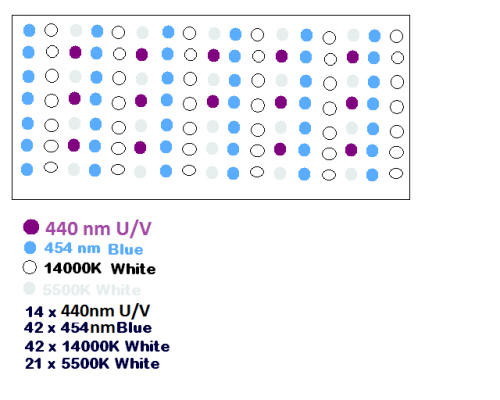
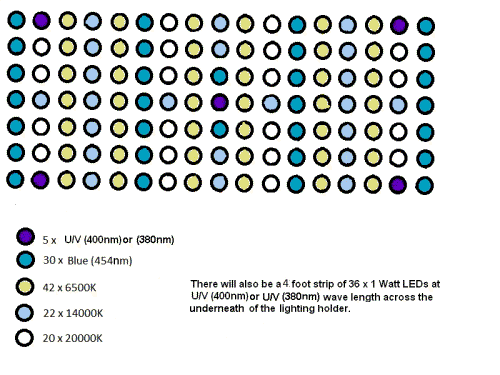
 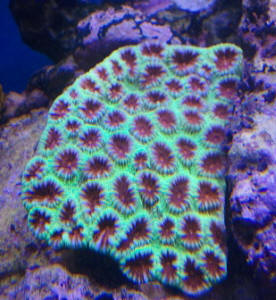
|
|
|

